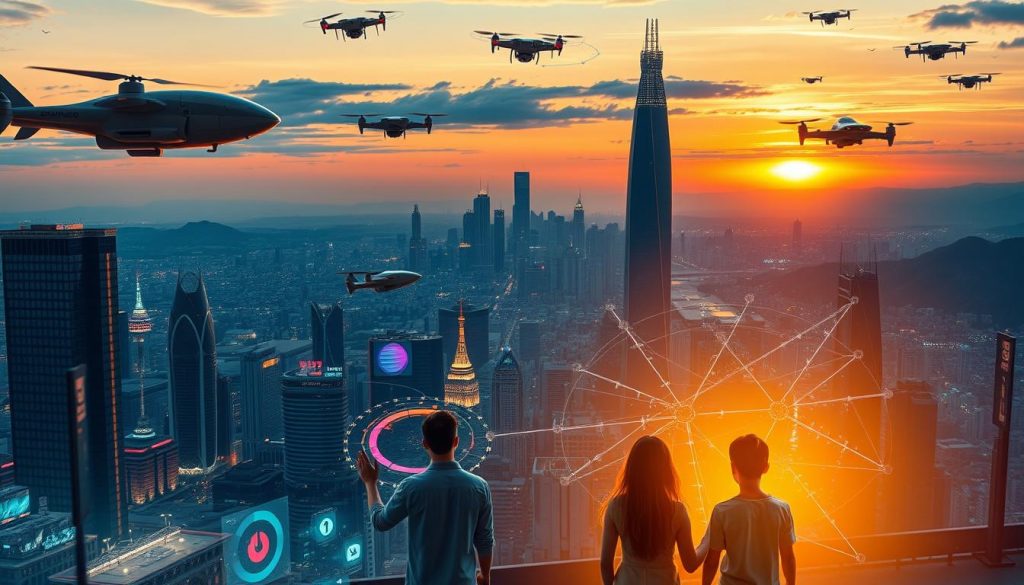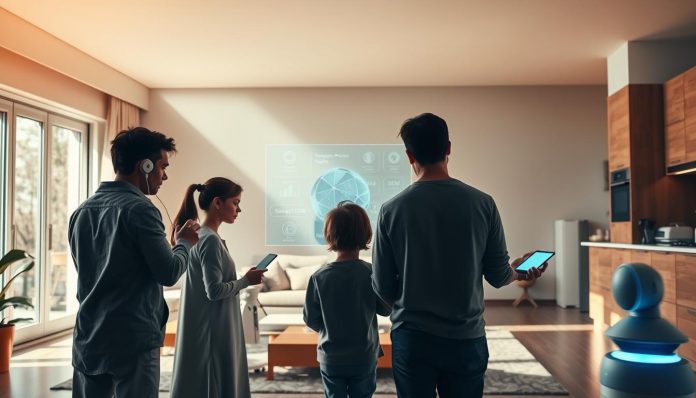3-Part Series: The AI-Powered Consumer Revolution
For Part 1: Living with AI: How Intelligent Devices Are Redefining Work, Home, and Health. Please follow the link.
Part 2: The Rise of AI-Powered Consumer Tech: Transforming Our Daily Lives
Have you ever stopped to wonder how much smarter your devices have become without you even noticing?
In 2025, artificial intelligence has firmly established itself as the driving force behind consumer technology. It’s no longer just about convenience – these technologies have woven themselves into the fabric of our daily lives.
From smartphones that anticipate needs to home systems that learn preferences, AI has revolutionised our interaction with technology. This remarkable rise signifies a shift in our relationship with devices.
What was once speculation is now reality. This section explores how this transformation reshapes modern living across the world.
Key Takeaways
- AI has become the cornerstone of consumer technology.
- AI integration makes devices intuitive and personalised.
- Technology has evolved from convenience to essential enhancement.
- Smartphones and home systems feature sophisticated AI capabilities.
- This transformation marks a shift in human-device interaction.
- Understanding this landscape offers insights into future developments.
AI Becomes the Foundation of Modern Living
Just a few years ago, AI felt like science fiction. Today, it forms the bedrock of our interaction with technology.
This transformation signifies a reimagining of what devices can accomplish with intelligence.
From Narrow Applications to Pervasive Integration
Early AI focused on single tasks. Recommendation engines suggested movies or products based on patterns.
Now these technologies permeate devices, integrating into smartphones and home systems.
This shift marks a pivotal moment. AI has become invisible infrastructure rather than a noticeable feature.
The Evolution of Consumer AI Capabilities
Modern systems possess remarkable capabilities that analyse patterns and adapt in real-time.
Natural language processing allows conversations with devices. Computer vision enables cameras to recognise scenes and optimise settings.
These advancements create personalised experiences. Devices understand context and preferences at new levels.
How Machine Learning Powers Everyday Experiences
At the core lies machine learning. This technology enables systems to improve through experience.
Your smartphone learns usage patterns to optimise battery life. Smart home systems adjust lighting and temperature automatically.
Even the photo quality is enhanced based on preferences. These improvements show machine learning’s impact on daily life.
This integration means AI influences everything from communication to entertainment, foundational to modern living.
What Defines AI-Powered Consumer Tech in 2025
Today’s smart devices can anticipate needs before users articulate them, a leap from earlier AI functions.
Technologies now learn, adapt, and personalise interactions across platforms, understanding context and predicting behaviors.
Modern AI systems analyse behavior patterns to build user profiles for individualised experiences.
These systems anticipate needs, recommending apps based on time or location.
This personalisation marks a shift from reactive responses to proactive assistance.
Contextual Awareness and Predictive Capabilities
Natural language processing enables meaningful conversations with virtual assistants, remembering past interactions.
Predictive algorithms forecast actions, adjusting environments before users notice changes.
This understanding fosters natural interactions, responding to subtle cues.
Seamless Multi-Device Intelligence Ecosystems
AI operates consistently across devices, transferring preferences seamlessly.
This ensures continuity across platforms, with tasks transitioning effortlessly.
The integration signifies innovation in technology design, creating a unified experience.
| Feature | 2015 Implementation | 2025 Capability |
|---|---|---|
| Personalisation | Basic recommendations | Anticipatory behavior prediction |
| Context Understanding | Single-query responses | Multi-turn conversational memory |
| Device Integration | Standalone functionality | Cross-platform intelligence sharing |
| Learning Capacity | Limited pattern recognition | Continuous adaptive improvement |
| User Experience | Manual configuration required | Automatic preference detection |
The evolution of consumer technology shows how AI shapes our digital future, relying on data processing while maintaining privacy.
Understanding these characteristics helps consumers make informed technology choices and insights into future innovations.
The Rise of AI-Powered Consumer Tech: Transforming Our Daily Lives
The Big Tech Players Redefining Everyday Experiences
Leading tech corporations embed AI, including generative AI, into flagship products, including smart home AI, creating almost magical experiences that transform interactions with devices.
Major companies drive this evolution with distinct approaches, each bringing unique strengths to AI integration.
Apple Intelligence: Deep iOS Integration
Apple Intelligence focuses on seamless integration within its ecosystem, learning user patterns to optimise performance.
It prioritises notifications and enhances battery management through usage analysis.
This integration creates a personalised, intuitive experience, benefiting users by understanding their habits.
Google Gemini and the Pixel Ecosystem: The AI-Camera Revolution
Google Gemini revolutionises mobile photography with computational imaging, automatically adjusting settings for perfect shots.
Low-light photography improves significantly, and portrait mode achieves professional results effortlessly.
These advancements make high-quality photography accessible, enhancing every image.
Amazon Alexa+: The Home’s Central Brain
Amazon Alexa+ voice assistant evolves into a home management system, coordinating smart devices.
The system recognises family members’ voices, personalising responses based on preferences.
Morning routines and lighting adjustments become automated, creating an intelligent living environment.
| Company | Specialisation | Key Innovation | User Benefit |
|---|---|---|---|
| Apple | OS Integration | Notification prioritisation | Reduced distraction |
| Computational Photography | Automatic optimisation | Professional images | |
| Amazon | Voice Control Ecosystem | Multi-user recognition | Home automation |
| All Platforms | Cross-Device Syncing | Seamless continuity | Uninterrupted flow |
These giants push boundaries with innovative products, driving rapid improvement in AI capabilities.
Consumers benefit from this race for smarter technology, enhancing human experiences through innovation.
How AI Is Transforming Daily Routines
Many now experience AI guiding their activities without realising it, a trend that will only expand with AI in 2025. This integration is a significant achievement of modern technology.
From alarms to relaxation, intelligent systems create efficient experiences throughout the day.
Morning to Night: AI’s Role in Everyday Activities
Smartphones analyse sleep patterns to find optimal wake-up times, considering cycles for gentle awakening, showcasing the role of artificial intelligence in daily life.
Morning briefings include personalised news and weather updates, while traffic conditions are checked automatically, further illustrating artificial intelligence in daily life.
Devices prioritise notifications, learning which require immediate attention, a key aspect of artificial intelligence in daily life.
Evening routines involve smart lighting and entertainment suggestions, adjusting home environments accordingly, demonstrating the impact of artificial intelligence in daily life.
Health and Wellness Monitoring Through Wearables
Wearables like the Apple Watch Series 8 track health metrics continuously.
Fall detection technology alerts emergency services if accidents occur.
Devices like the Oura Ring provide sleep analysis and improvement recommendations.
These technologies help people understand their health better, offering actionable insights.
Smart Home Automation and Energy Efficiency
Thermostats learn routines, adjusting temperatures based on occupancy.
Lighting systems dim when unoccupied, optimising efficiency.
Energy patterns are analysed to suggest reductions in consumption.
These features create comfortable environments and save costs.
| Activity | AI Feature | Benefit | Example Device |
|---|---|---|---|
| Sleep Management | Sleep stage tracking | Improved rest quality | Oura Ring |
| Health Monitoring | Real-time vital tracking | Early issue detection | Apple Watch Series 8 |
| Home Climate Control | Occupancy-based adjustment | Energy savings up to 23% | Nest Learning Thermostat |
| Lighting Management | Motion pattern learning | Reduced electricity use | Philips Hue System |
| Safety Features | Automatic fall detection | Emergency response coordination | Modern Wearables |
These advancements show AI’s practical benefits, making life more convenient and efficient.
People rely on these technologies effortlessly, enhancing daily experiences.
Retail Gets Smarter with OpenAI Lead Agentic Commerce
Shopping experiences have transformed through AI integration. Retail environments now use systems that understand customer preferences and optimise operations.
Conversational Commerce and Personal Shopping Assistants
Modern retail platforms use natural language processing for customer interactions. AI assistants engage in dialogues to understand shopping needs.
They provide tailored recommendations and support during the purchasing journey, mimicking human assistance with 24/7 availability and consistent service.
Hyper-Personalised Product Recommendations
Machine learning algorithms analyse customer data to deliver relevant suggestions, considering search history and purchase patterns.
These systems identify preferences that customers may not consciously recognise, creating a shopping experience aligned with individual tastes.
AI-Driven Supply Chain and Inventory Management
Intelligent systems revolutionise backend operations with predictive analytics. They forecast demand accurately using multiple data sources.
Inventory management optimises waste reduction while ensuring product availability. Logistics benefit from route optimisation and real-time adjustments.
This approach transforms retail into a predictive, efficient operation, enhancing experiences for both customers and retailers.
The Next Two Years: Where AI Consumer Tech Is Headed
Over the coming years, consumer AI will undergo transformative changes across multiple domains. These advancements promise to reshape how people interact with technology in their daily routines.
Three significant developments will characterise this evolution. They represent both technological progress and responsible innovation.

Emerging Trends in Agentic AI and Autonomous Systems
Agentic artificial intelligence systems are becoming increasingly autonomous. These systems can perform complex tasks without constant human supervision.
In retail environments, AI agents now handle customer inquiries and process orders independently. Healthcare applications include monitoring patient vitals and alerting professionals to changes.
This autonomy represents a significant shift from assisted to independent operation. Systems learn from interactions and improve their decision-making capabilities over time.
The Convergence of AI with Augmented Reality
Augmented reality platforms are integrating sophisticated artificial intelligence capabilities. This combination creates immersive experiences that blend digital and physical worlds.
Smart glasses now overlay contextual information based on real-time environment analysis. Navigation systems provide visual directions while recognising obstacles and suggesting alternatives.
These systems understand spatial relationships and object recognition simultaneously. They create practical applications for the education, maintenance, and entertainment sectors.
Conclusion: The Rise of AI-Powered Consumer Tech: Transforming Our Daily Lives
Artificial intelligence has fundamentally reshaped modern existence through smarter, personalised technology integration. This evolution makes devices indispensable companions in daily routines.
The rise of intelligent systems sets the stage for continuous innovation. Future developments will bring even more seamless experiences while prioritising ethical considerations.
Looking ahead, this technology will enhance efficiency, health, and convenience in unimaginable ways. It represents a permanent transformation in how people interact with their environment.


